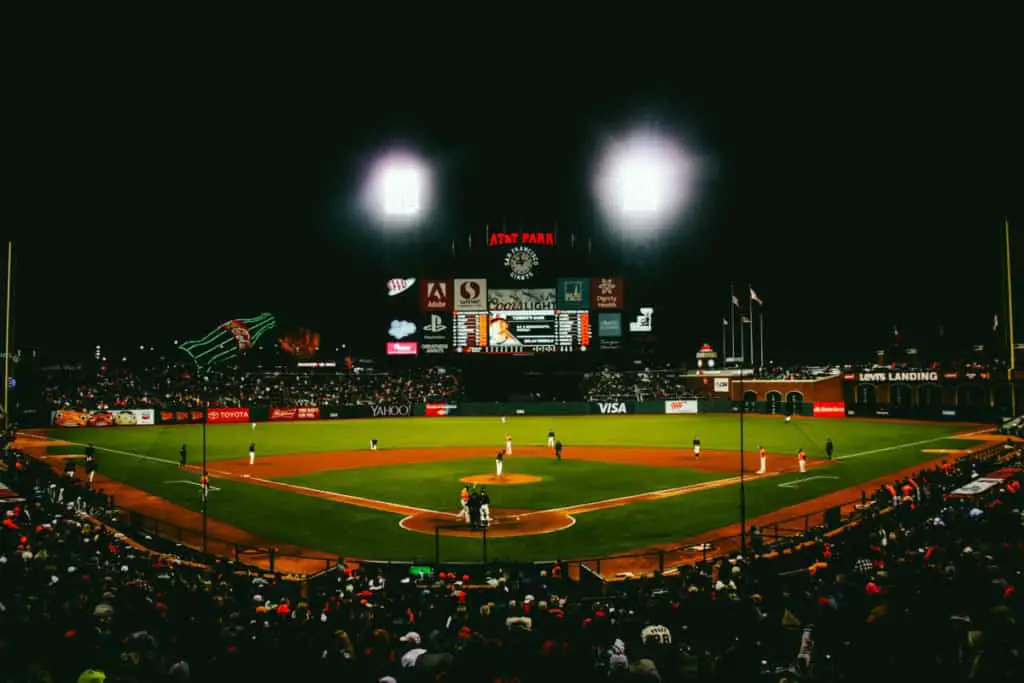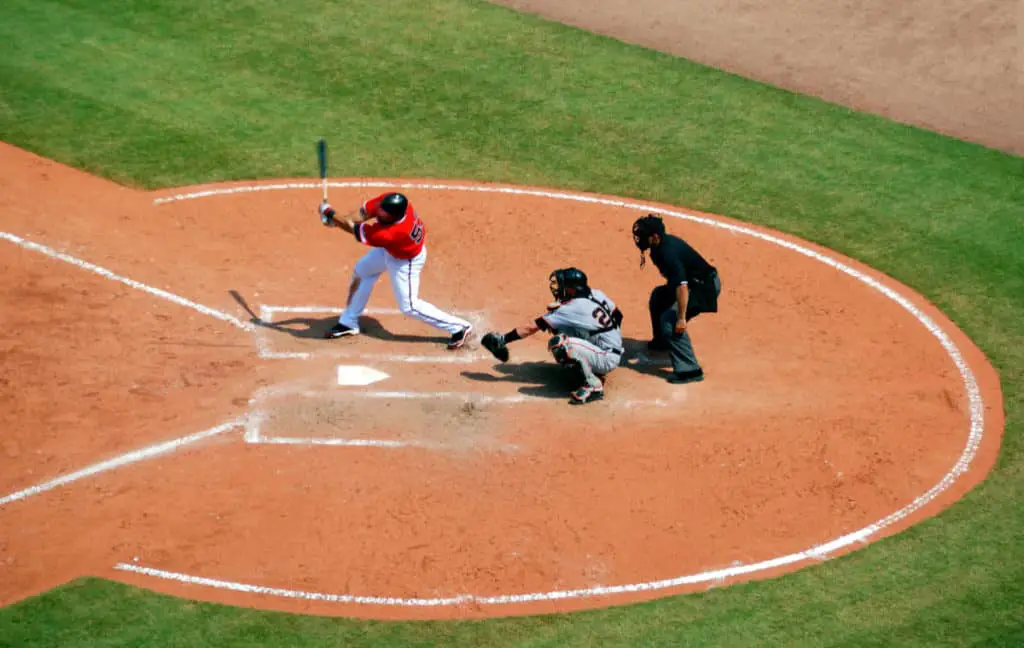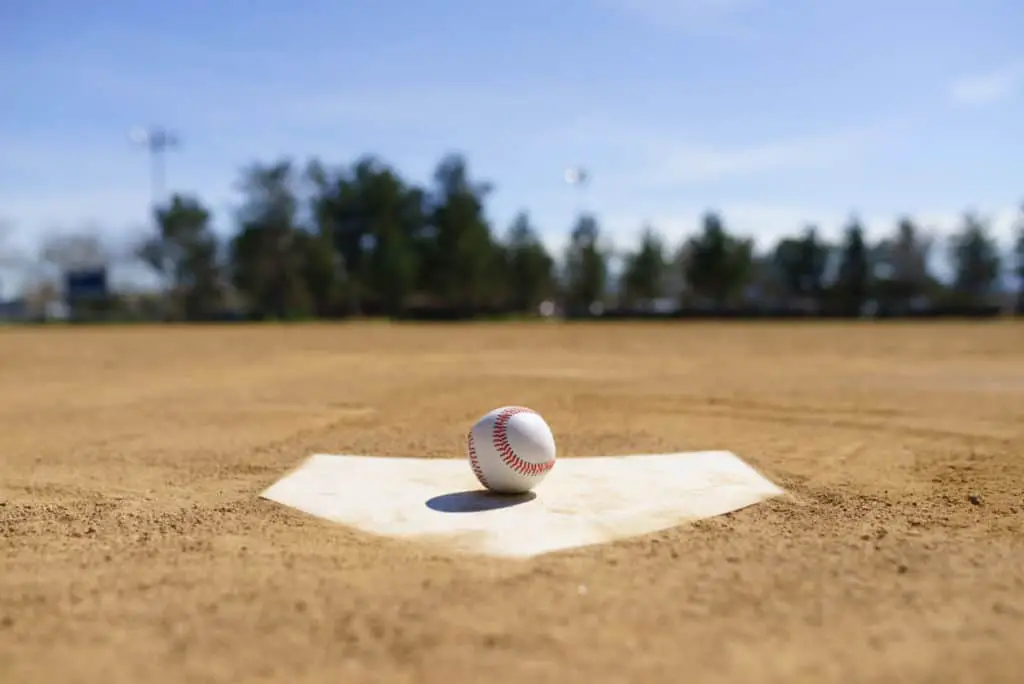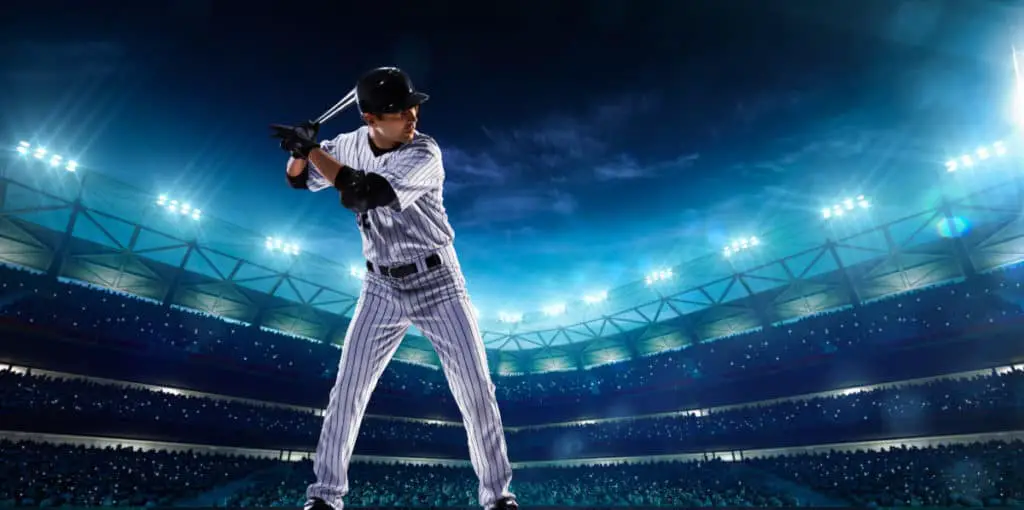Here at SportsWarrior365 we love the game of baseball. We have played and coached for most of our lives. The game can bring great enjoyment and excitement for people of all ages and skill levels. There are people that love baseball and some people think it is boring.
Regardless, we love the game and find it very exciting for many different reasons. We remain active in coaching little league baseball and high school baseball.
We receive a lot of different questions about sports and hope to provide some key answers, and also help you in your journey whether you play, coach or are supporting your kid in their journey.
We provide a complete overview of a baseball roster and break it down by each area of a roster including the starters, the starting pitching rotation, the bullpen and the bench.

How many baseball players are on a team?
In Major League Baseball, there are 25 players on the roster. For little league teams or high school teams there are typically 11 to 12 players on the team. Overall, nine players play at a time with the occasional “extra hitter” or EH at some little league levels.
Roster Overview – Major League Baseball
Major league baseball teams have 25 players on the roster. This number does expand with September call ups to provide teams with greater flexibility in the last month of the season and additional opportunities for some of the younger, up-and-coming, future stars.
Managers and general managers have to consider the strengths and weaknesses of their teams, current injuries, and the starting pitching rotation. There are many factors that influence players getting put on the disabled list, and getting called up and down from AAA baseball.
The management of the 25 man roster is a daily exercise for the manager. At times, depending on the recent load of the bullpen, moves can be made to bring up extra pitching.
There are always several players on a team that seem to go back and forth between the major leagues and the AAA level of baseball. Younger players will take any chance they have to make an impression when they get that opportunity.
Often times, an injury can lead to this opportunity. With baseball playing a 162 game regular season, there are many injuries that a team must deal with. It is a 6 month marathon with teams grinding it out trying to make the playoffs.
Managers seek versatility in their lineups and prefer players, especially the bench players, to have the ability to play multiple positions also be able to pinch run or pinch hit. Either way, the non starters must be versatile and provide options.

Starting Lineup (9-10 players)
Each starting lineup has 9 players and in the the American League a 10th player known as the designated hitter or the DH. The positions include the following:
- Pitcher – 1
- Catcher – 2
- First base – 3
- Second base – 4
- Third base – 5
- Shortstop – 6
- Left field – 7
- Center field – 8
- Right field – 9
- Designated hitter – American League only
Looking for a complete breakdown on all of the positions, check out our posts here.
Starting Rotation (5 Players)
Most major league teams carry and utilize a five man pitching rotation. This means that each pitcher starts every 5th day. For the most part, the other four days the pitchers are not used in any role. The only exception is when the playoffs roll around.
The hope is that each pitcher can pitch 6 to 7 innings and take some pressure off the bullpen. Ideally this happens, but not usually. Some of the best pitching rotations are known to play golf on their off days. This can be a great gig if you could get it.
Starting pitchers usually have a variety of pitchers, most will have three above average pitches. These include fastball, change up, breaking ball, etc. Some pitchers, later in their career, will transition to the bullpen. Also, some of the younger pictures break into the major leagues by starting in the bullpen.
Bullpen (7-8 Players)
Most major league teams carry 7 to 8 pitchers in the bullpen. This puts a total of 12 to 13 pitchers on the roster. The manager must play a major role in proving balance in the bullpen and the workload of each pitcher.
With major league teams making big investments in their pitching staff, they want to ensure they keep guys healthy. The most important position in the bullpen is the closer.
This pitcher will pitch the last inning or two in close games to try to secure the final 3 to 6 outs. This is when the pressure is the most intense and the other team pulls out all stops to tie the game up or to take the lead.
You’ll see many blown saves throughout the year and the top closers in the league carry a high value. The setup guy in the bullpen is another important pitcher who will pitch typically the seventh or eighth inning in a close game.
You also find managers working the lefty/righty matchups. The left handed pitcher is vital in the most dominant bullpens. They are brought in to secure the outs against the most dangerous left-handed hitters.
Bullpen pitchers usually are more power throwers that might only have two above average pitches. Most players become bullpen pitchers if they struggle to be a starter.
This can occur for different reasons including not having enough above average pitchers, the stamina to pitch 6 or 7 innings per outing or the ability to hold base runners.
Players can be moved to the bullpen to allow them to pitch one or two innings at a time and bring the fastball with one other complimentary pitch. With only pitching one or two innings, the pitchers do not have to worry about facing the lineup a second time through, at least during that game.
The lefty specialist in the bullpen needs to be able to get the left handed power hitters out. Some of the best have a quality breaking ball and might be the power thrower that the right handed pitchers are.
The best lefty pitchers can get hitters out from both sides of the plate, which provides greater versatility for the manager.
If a bullpen pitcher throws several days in a row, sometimes he is unavailable for the next game and the manager can work around this scenario. The daily management of who can pitch and who cannot is a major stressor on baseball managers.

Position Players/Starters (9-10 Players)
The starters on a team play the majority of the games. On occasion, they will get a day off to make sure they are fresh and can stay strong for the duration of the season.
Usually 7-8 of the players will play a high percentage of the games. If they are switch hitters, this is an advantage to the team and the manager. It provides greater flexibility with the batting lineup regardless of who is pitching. Sometimes, your power left handed hitter might struggle against a left handed starting pitcher.
There are players who are replaced if their stats against the lefty pitchers are poor.
Starts must be solid defensively and offensively. There are always players that are stronger with one side of the game versus the other. This is usually balanced out by the different players on the team. The catcher, shortstop and center fielders must be strong up the middle.
Teams will sacrifice the offensive production of these three positions to provide quality defense and to create extra outs of the pitchers. On the other side, the corner infields and corner outfields may be weaker on defense, but if they can hit for a high average, hit a lot of home runs, or be a great run producer a team is willing to sacrifice a bit on the defensive side of the game.
The Designated Hitter, only used in the American League, is typically a player with some decent pop in their bat.
Managers will often create their lineups each day by looking at the analytics provided based off of the expected starting pitcher for that day’s game. You will see adjustments based on injuries, past performance, how many days in a row a player has played and other factors.
Managers must balance the 162 season and keep the big picture in mind.
Every wonder what the “5 Tools” in baseball are? Check out this post, here.
Bench (2-3 Players)
The bench is usually made of 3-4 players depending on the number of bullpen pitchers on the roster. These 3 to 4 positional players must be able to play multiple positions defensively.
Late in games, they must also be able to pitch run for the slower players or pinch hit if a lefty is brought in against another lefty who traditionally struggles against a lefty pitcher. These in game adjustments by the manager is like a chess match to see what advantage they can gain against the other team.
These bench players also get the occasional opportunity to start depending on many factors. Many teams do not like to call up the younger players to fill bench roles because they want them getting game at bats and want them to further develop at the minor league level versus only playing 1-2 times per week or getting the occasional at bat through a pinch hit opportunity.
The ability to pinch run is very important late in the if someone starts off an inning with a double and the runner is slower, you might see a pinch runner take his place in hopes of being able to score on a base hit to the outfield.
Or if a pinch runner at the ability to steal a base, he can change the complexion of the game by stealing second base and then scoring on a base hit. Most teams will carry one player that has exceptional speed and base running abilities.

How Many Players – Little League Rosters
Little league rosters are usually made up of 11-12 players. The best coaches ensure that all players have an opportunity to develop and get better throughout the season.
There isn’t the great level of management that is required at the major league level. All kids should continue to take ground balls and practice the outfield to help them become the most all around player possible for later in their careers.
Specializing at a position other than catcher early on, could become detrimental to the players future. The best coaches are able to balance this and provide opportunity for overall development.
How Many Players – High School Rosters
Most high school varsity rosters are made up of 12-13 players. It might be better for a younger player to get the daily at bats at a Junior Varsity level as opposed to sitting on the Varsity bench. The 3-4 players not starting need the versatility and the ability to pinch run or be a defensive replacement late in the game.
Often times a player in the game might be the relief pitcher for that day. The coach must ensure that player can warm up while their own team is at bat. This can get tricky for the manager.
Related Questions…
What role does the DH play?
The designated hitter is typically a very good hitter that may not be that great defensively. In the American League the DH hits usually for the pitcher.
The pitcher is a specialist in pitching and most are not very good at hitting, but there are also some exceptions to this rule. Overall, the DH must add value to the lineup and hopefully bat somewhere in the top 6 in the lineup. These positions are sometimes filled by the more veteran players that may have lost a step or two defensively.
What is the most important bench position?
In our opinion, the players that can play 4-5 positions defensively and pinch run. As the games move into the later innings, the ability to produce a run or step up and improve the defensive if you have a lead is vital to the overall success of a team, especially over a 162 game season. These players are hard to find, but truly bring some value to a team.
What is a platoon system?
In a platoon system, some players may only play depending on who is pitching. For example, if there are two left fielders on a team, one might play against certain pitchers and the other will play against certain other pitchers. This is often times based on what arm the pitcher throws with.
If you have someone that hits 300 off of a righty and only 230 off a a lefty and the other player on the team has the opposite stats, you pretty much can get a 300 hitter out of two guys at one position. This versatility is what managers prefer.
Why are there so many pitching changes?
Bullpen pitchers are typically specialists who have more success against a specific type of hitter. For example, a lefty, soft throwing pitcher might have a lot of success against a left handed hitter, but will probably struggle against the right handed hitter. The manager must know his staff and have analytics about the opposing team and who they would struggle against match up wise.
And Finally…
Baseball is a strategic game where the manager has a great impact on the game simply with just setting the lineup and then managing that lineup throughout the game.
He must know who is feeling good, the analytics and have a good grasp on what is taking place in the game. A coach will have a bench coach that is there to consult with and have in game conversations. There is also the pitching coach to help the pitchers directly and consult with the manager.
You will also see a hitting coach working with hitters on mechanics and more importantly the approach the other team is taking to try to get the guy out. Baseball is a thinking game full of strategy which is why the pure baseball fan loves the game.
The next time you attend a game, look for these matchups and watch closely the substitutions and the pitching changes that are made. The game can become more intriguing and interesting.
Do you Love Baseball? Check out our baseball related posts, here.
